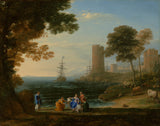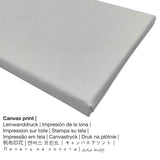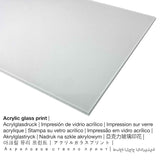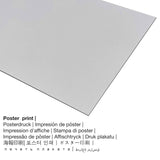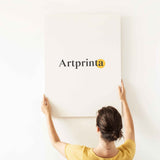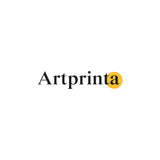Claude Lorrain, 1645 - Coast View with the Abduction of Europa - fine art print
Tax included. Shipping calculated at checkout.
The 17th century masterpiece with the title Coast View with the Abduction of Europa was created by the baroque painter Claude Lorrain in 1645. It is part of the collection of The J. Paul Getty Museum, which is part of the J. Paul Getty trust and is one of the world's largest arts organizations worldwide. It seeks to inspire curiosity about, and enjoyment and understanding of, the visual arts by collecting, conserving, exhibiting, and interpreting works of art of outstanding quality and historical importance.. With courtesy of The J. Paul Getty Museum (license - public domain).The creditline of the artwork is the following: . Furthermore, alignment of the digital reproduction is landscape and has a side ratio of 4 : 3, which implies that the length is 33% longer than the width. Claude Lorrain was a male painter, whose artistic style can primarily be classified as Baroque. The painter lived for a total of 82 years, born in the year 1600 in Champagne, Auvergne-Rhone-Alpes, France and deceased in the year 1682 in Rome, Roma province, Lazio, Italy.
Original information about the work of art from the museum's website (© Copyright - by The J. Paul Getty Museum - The J. Paul Getty Museum)
The maiden Europa rests atop a white bull, unaware it is the god Jupiter in disguise. According to the tale in Ovid's Metamorphoses, soon the animal will abduct her across the waves. Until then, she and her attendants festoon the seemingly innocent beast with flowers, while her blue drapery flutters in the breeze. In the upper right corner, a hazy poetic light illuminates her home city of Tyre, further evoking an idyllic antique world.
Claude Lorrain is known for painting complicated images that achieve a tranquil balance. This scene appears bucolic, but his composition and details also hint of impending danger. Beyond the field of delicate flowers, for example, a craggy tower looms. The women fail to notice that the bull is poised in anticipation, already straightening one of his legs for flight. Whitecaps gather behind them on the darkening sea, the backdrop to Europa's fate.
Even in his day, Claude was known for developing a style called the Ideal Landscape, in which nature on the canvas surpasses the real thing in its beauty, harmony, and refinement. Here he balances formal elements, like the upright trees, ship, and towers, against the open expanse of sea and sky. Offshore, he juxtaposes the huge galleon and all its impeccable detail in the rigging and carved decoration, with Europa still on land. The maritime theme also had a deeper resonance for Claude's contemporaries, as in art criticism, the abduction of Europa was compared to a ship leaving shore.
French by birth, and working in Rome, Claude often went into the countryside to do studies of nature. One of his hallmarks is the use of a unifying light, which gives this work a kind of gentle glow. The romance is punctuated by long shadows coming in from the left, distinctive of his favorite afternoon light, which help frame the drama at center stage.
Structured table of the work of art
| Name of the painting: | "Coast View with the Abduction of Europa" |
| Classification of the work of art: | painting |
| General category: | classic art |
| Period: | 17th century |
| Created in the year: | 1645 |
| Approximate age of artwork: | 370 years |
| Museum / location: | The J. Paul Getty Museum |
| Museum location: | Los Angeles, California, United States of America |
| Available at: | The J. Paul Getty Museum |
| License: | public domain |
| Courtesy of: | The J. Paul Getty Museum |
Artist table
| Artist name: | Claude Lorrain |
| Additional names: | Cluade, Lorenis, Loren Claudio, Claude of Lorraine, C. Loranese, Claude la Lorain, C. Laurain, Gillee Le Lorrain Claude, Glaude Sorrin, Gio: Carlo Loréno, Claudius Gelle, Claudio Gele, C. de Lorraine, claude gelee gen. lorrain, Claude Gelé dit le Lorrain, Cl. Lorrain, Gloude Loronois, Clode Loraine, Claude Lorrain, Claude Loirainois, C. Le Lorrain, Claudio Lorenese, Claude (Claude Lorrain) Gellée, le Lorain Claude, Glaude Laurainois, Lorena Claudio di, Claude Gelée genannt Lorrain, Claude Lauren, Claude dit le Lorrain, Claude Gellée gen. Claude Lorrain, Glaude Lorenois, Msù Claudio Lorenese, [Claude Lorrain], Lorense Claudio, Lorrain Claude Gelee gen. Le Lorrain, Claude Gellée dit Le Lorrain, Loranese, Monsu` Claudio, Lorineses Glaudo, C. Loraneze, Claudio Rorenese, Lorraine, Lorrain Claude Gelee gen., Glot la Raing oder Claudius Gelee, C. Laurin, Glaude d'Loraine, Gloude Loranois, Le Lorrain, Gellée Claude (Claude Lorrain), Claude Gelée dit le Lorrain, Claude Gelez dit le Lorrain, Gellée le Lorrain Claude, Gelleè Lorenese Claudio, C. de Lorrain, Claude Gellé gen. Le Lorrain, Gelee Claudius, Msù Claudio, Claudio Gelée, Claude le Lorrain or Claudius Gelée, Claude le Lorrain, Claudius Gelee, Claud de Loraine, Claude Gelée gen. le Lorrain, Claude Gille, Cl. le Lorrain, Claude Gelée dit le Lorrin, Lorrain Claude, C. Gelée dit le Lorrain, Claude, claude gellee gen. lorrain, Glaude de Lorainois, Claude Gellee Le Lorrain, Claude Lorraine, Claud Lorraine, Claude Gelée genannt Le Lorrain, Claude Lourin, Cl. Gelée dit Le Lorrain, C. Loraine, Lorenese Claudio Gelée, Glaude Lornois, Claude de Lorin, Glaude Lauranois, Claud. Loraine, C. Lorrain, Gelee Claude, Gellée Claude, Claude Le Lorin, Claude Lorraine, Claude Lorrain, Claude Gelée dit Lelorrain, Claudio di Lorena, Glaude Loronois, ז'לה קלוד (המכונה קלוד לורין), Glaudo Lorinees, Claudio Loren, Claude de Lorrain or Claudius Gelée, Claude Lorrain (Claude Gellée), Monsu Claudio, Clot la Raing oder Claudius Gelee, Claude Loreen, Claude Loranese, Cl. Lorraine, Claude L'oronois, Claud. Lorrain, Cladio Gelleè Lorenese, Claude-loraine, Lorrain, Glaude de Loronoy, Claud de Lorain, Claude Gélé dit Le Lorrain, Glaude Lorraine, Lorraine Claude, Monsù Lorense, Claud Loraine, Claude Gellee gen. Le Lorrain, Claude Lorain, Gloude Lorenois, Claude Lorenois, Clodio, Lorenese, Lorain Claude la, Claudio Gilet Lorraine, Le Lorrain Claude, Claudius Gelée genannt Claude Lorrain, Claude Gellé dit le Lorrain, Claude Gelée, Claude le Lorain, Lorenese Claudio, Claudio Lurinese, Cl. Gelée dit Le Lorrain, Glaude Lorenne, Clauade, Claude Gelleé Le Lorraine, Gellée Claude Lorrain, Claude Gele dit Lorraine, Claude Le Laurain, Claude Laurrin, claude gelee gen. lorrain, Claude Lorin, Claude Loraine, Claude Lorraine French, Glaude Loranois, Claude Lorainois, Lorrain Claude de, Claude le Lorraine, Claude Gelee Called Claude Lorrain, Gelée Claude gen. Lorrain, Gelée dit Claude le Lorrain, Cloth. de Loraine, Lorrain Claude Gellée, Claude Lorrraine, Gelè Claudio, C. Lorraine, Claudio da Lorena, Claude Gelé dit Lorraine, Lorin, Claude Gele'e dit le Lorrain, Cla. Lorraine, Claude Gelee genannt le Lorrain, Claude Gelee called Le Lorraine, Claud, Claudio Gelleè Lorenese, Claude Gielis de Larins, Glaude Loranoijs, Glaude, Glaude Lorainois, Claude Gelée dit le Lorrain, Claude Gellée Le Lorrain, Claudele Lorrain, Cl. Lorain, Lorena Claudio, Gelleé Le Lorraine Claude, Claude Lorrains, Claude Gelée dit Claude le Lorrain, Claude le Loraine, Loraine Claude, Carlo Loranze, Claudio Loroinese, Clode Lorraine, G. De Lorain, Monsu Claudio Lorenese, Claudio Lorense, Claudio Loranese, Claude Lorrain Eigentlich Claude Gelee, Lorain Claude, Claud Lorain, Claud. Larenese, Lorain, Monsu Clodio, Lorena Claudio de, Carlo Loraneze, Claudie, Claude de Lorraine, Gloude Lornois, lorrain claude, Claude Gellée, Lorrain Claude le, Charles de Lorrain, Claude Laurain, Claudio, Claud Lorrain, Claude De Laureins, Lorrain Claud., Gelè Claude, C. Gelée dit le Lorrain, Ch. Lorrain |
| Gender of the artist: | male |
| Nationality of artist: | French |
| Jobs: | painter |
| Country of the artist: | France |
| Classification of the artist: | old master |
| Art styles: | Baroque |
| Life span: | 82 years |
| Born in the year: | 1600 |
| Place of birth: | Champagne, Auvergne-Rhone-Alpes, France |
| Year died: | 1682 |
| Died in (place): | Rome, Roma province, Lazio, Italy |
Materials you can pick from
In the product dropdown selection you can pick the size and materialaccording to your personal preferences. You can choose among the following product customization options:
- The poster print (canvas material): Our poster print is a UV printed canvas paper with a nice surface texture. Please note, that depending on the absolute size of the poster we add a white margin of approximately 2-6cm round about the painting in order to facilitate the framing with your custom frame.
- Print on acrylic glass (with real glass coating): An print on acrylic glass, often named a plexiglass print, will convert the original into great home decoration. Your favorite work of art is being made with the help of modern UV direct printing technology. The image effect of this are deep and vivid colors. Our real glass coating protects your selected fine art print against light and heat for between 40-60 years.
- Metal (aluminium dibond print): An Aluminium Dibond print is a print material with an impressive depth. The non-reflective surface make a contemporary look. The Direct Print on Aluminum Dibond is your ideal start to fine art replicas on aluminum. For our Direct Print On Aluminum Dibond, we print your chosen artwork onto the surface of the white-primed aluminum composite. The bright components of the original artpiece shimmer with a silky gloss, however without any glare.
- The canvas print: The printed canvas, which should not be confused with a painting on a canvas, is a digital copy printed on a cotton canvas material. Hanging a canvas print: A canvas print has the advantage of being relatively low in weight, meaning that it is easy and straightforward to hang your Canvas print without the help of any wall-mounts. A canvas print is suited for any type of wall.
Article specs
| Article categorization: | art reproduction |
| Reproduction: | digital reproduction |
| Production technique: | UV direct print |
| Manufacturing: | manufactured in Germany |
| Type of stock: | on demand |
| Product usage: | art print gallery, wall decoration |
| Artwork alignment: | landscape format |
| Aspect ratio: | length to width 4 : 3 |
| Image ratio meaning: | the length is 33% longer than the width |
| Available reproduction fabrics: | metal print (aluminium dibond), canvas print, acrylic glass print (with real glass coating), poster print (canvas paper) |
| Canvas on stretcher frame (canvas print) size options: | 40x30cm - 16x12", 80x60cm - 31x24", 120x90cm - 47x35", 160x120cm - 63x47" |
| Acrylic glass print (with real glass coating): | 40x30cm - 16x12", 80x60cm - 31x24", 120x90cm - 47x35", 160x120cm - 63x47" |
| Poster print (canvas paper) size variants: | 40x30cm - 16x12", 80x60cm - 31x24", 120x90cm - 47x35" |
| Aluminium dibond print size options: | 40x30cm - 16x12", 80x60cm - 31x24", 120x90cm - 47x35" |
| Framing of the art reproduction: | please note that this art print has no frame |
Legal disclaimer: We try our best in order to depict our art products with as many details as possible and to demonstrate them visually on the respective product detail pages. Nevertheless, the colors of the print materials, as well as the printing can differ to a certain extent from the presentation on your device's screen. Depending on your screen settings and the nature of the surface, color pigments might not be printed as exactly as the digital version. Because all our art prints are processed and printed manually, there may as well be minor variations in the size and exact position of the motif.
© Copyright of - Artprinta.com (Artprinta)

